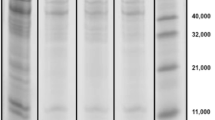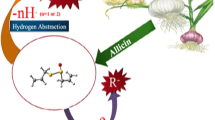Abstract
The essential mediatory role of copper and iron in a variety of free radical-induced injuries, including paraquat-induced biological damage has been recently demonstrated. It was postulated that these transition metals undergo cyclic redox reactions, and serve as centers for repeated production of hydroxyl radical, which are the ultimate deleterious agents. Additionally, we had presented evidence indicating efficient protection against paraquat toxicity by agents commonly employed (chelators, chemical scavengers and protecting enzymes).
In this study we have used theE. Coil model in order to develop a new approach for protection against paraquat-induced metal-mediated cellular injury. It entails the administration of excess zinc (up to 50 fold over copper), which results in an inhibition of the toxic effect of paraquat. Lineweaver- Burk analysis demonstrates the competitive mode of this inhibition. The suggested mechanism involves the displacement of the redox-active copper (or iron) from its binding site and by this diverting the site of repeated production of free radicals. Thus, use of redox-inactive metals, which possess high similarity of their ligand chemistry, to that of iron and copper but are of relative low toxicity by themselves, should be considered for intervention in paraquat toxicity and in other metal-mediated free radical-induced injurious processes.
Access this chapter
Tax calculation will be finalised at checkout
Purchases are for personal use only
Preview
Unable to display preview. Download preview PDF.
Similar content being viewed by others
References
Calderbank, A. (1968) Advn. Pest. Control Res. 2, 127–131.
Dodge, A.D. (1971) Endeavour 111, 130–135.
Dasta, J.F. (1978) Am. J. Hosp. Pharm. 25, 1368–1372.
Autor, A.P. (1974) Life Sci. 14, 1309–1319.
Naito, H., and Yamashita, M. (1987) Human Toxicol. 2, 87–89.
Hassan, H.M., and Fridovich, I. (1978) J. Biol. Chem. 253, 8143–8148.
Hassan, H.M., and Fridovich, I. (1979) J. Biol. Chem. 254, 10846–10852.
Hassan, H.M., and Fridovich, I. (1979) Arch. Biochem. Biophys. 196, 385–395.
Delval, P.M., and Gillespie, D.J. (1985) Crit. Care Med. 13, 1056–1060.
Smith, L.L. (1986) Annu. Rev. Physiol. 42, 681 -692.
McCord, J.M., and Day, E.D. (1978) FEBS Lett. 22,139–142.
Halliwell, B. (1978) FEBS Lett. 22, 321 -326.
Aust, S.D., Morehouse, L.A., and Thomas, C.E. (1985) J. Free Rad. Biol. Med. 1, 3–25.
Halliwell, B., and Gutteridge, J.M.C. (1986) Arch. Biochem. Biophys. 246. 501–514.11.
Kohen, R., and Chevion, M. (1985) Free Rad. Res. Commun. 1, 79–88.
Korbashi, P., Kohen, R., Katzhendler, J., and Chevion, M. (1985) J. Biol. Chem. 221, 12472–12476.
Kohen, R., and Chevion, M. (1988) Biochemistry 2Z, 2597–2603.
Samuni, A., Chevion, M., and Czapski, G. (1981) J. Biol. Chem. 225, 12632–12635.
Shinar, E., Navok, T., and Chevion, M. (1983) J. Biol. Chem. 253, 14778–14783.
Navok, T., and Chevion, M. (1984) Biochem. Biophys. Res. Commun. 122, 297–303.
Levine, R.L, Oliver, C.N., Fulks, M.R., and Stadtman, E.R. (1980) Proc. Natl. Acad. Sci. USA ZS, 2120–2124.
Chevion, M. (1988) Free Rads Biol. Med. 5, 27–37.
Kohen, R., Korbashi, P., and Chevion, M. (1983) in: Paraquat Toxicity is Mediated by Transition Metal Ions, Abstract of the First Meeting of Israel Societies of Life Science, Jerusalem, October, 1983.
Sutton, H.C., and Winterbourn, C.C. (1984) Arch. Biochem. Biophys. 235. 106–115.
Winterbourn, C.C., and Sutton, H.C. (1984) Arch. Biochem. Biophys. 225, 116–126.
Kohen, R., and Chevion, M. (1985) Biochem. Pharmacol. 34,1841–1843.
Hegetschweiler, K., Saltman, P., Dalvit, C., and Wright, P. (1987) Biochem. Biophys. Acta 912 (3)384–397.
Cotton, F.A., and Wilkison, G. (1972) in: Advanced Inorganic Chemistry, New York: Interscience Publishing, 1972.
Eguchi, L.A., and Saltman, P. (1987) Inorg. Chem. 26, 3665–3669.
Eguchi, L.A., and Saltman, P. (1987) Inorg. Chem. 26, 3669–3672.
Stability Constants of Metal-Ion Complexes, Part B: Organic Ligands: IUPAC Chemical Data Series,No. 22, (Perrin, D.D., ed.) Pergamon Press, Oxford (1979).
Segel, I.H. (1975) in: Enzyme Kinetics, pp. 161–166, A Wiley-lnterscience Publications, John Wiley and Sons, New York.
Anderegg, G. (1982) Pure Appl. Chem. 54, 2693–2758.
Willson, R.L. (1977) In: Iron Metabolism, Ciba Foundation Symposia, 51, 331–354.5
Willson, R.L. (1977) New Scientist, 1 December, 558–560.
Chvapil, M. (1973) Life Sci. 13, 1041–1049.
Girotti, A.W., Thomas, J.P., and Jordan, J.E. (1986) Arch. Biochem. Biophys. 251. 639–653.
Author information
Authors and Affiliations
Editor information
Editors and Affiliations
Rights and permissions
Copyright information
© 1990 Plenum Press, New York
About this chapter
Cite this chapter
Chevion, M., Korbashi, P., Katzhandler, J., Saltman, P. (1990). Zinc — a Redox-Inactive Metal Provides a Novel Approach for Protection Against Metal-Mediated Free Radical Induced Injury: Study of Paraquat Toxicity in E. Coli . In: Emerit, I., Packer, L., Auclair, C. (eds) Antioxidants in Therapy and Preventive Medicine. Advances in Experimental Medicine and Biology, vol 264. Springer, Boston, MA. https://doi.org/10.1007/978-1-4684-5730-8_35
Download citation
DOI: https://doi.org/10.1007/978-1-4684-5730-8_35
Publisher Name: Springer, Boston, MA
Print ISBN: 978-1-4684-5732-2
Online ISBN: 978-1-4684-5730-8
eBook Packages: Springer Book Archive




